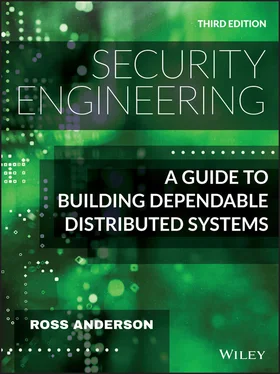3.4.7 Protecting oneself or others?
Next, to what extent does the system need to protect users and subsystems from each other? In global systems on which anyone can get an account – such as mobile phone systems and cash machine systems – you must assume that the attackers are already legitimate users, and see to it that no-one can use the service at someone else's expense. So knowledge of one user's password will not allow another user's account to be compromised. This has both personal aspects, and system aspects.
On the personal side, don't forget what we said about intimate partner abuse in 2.5.4: the passwords people choose are often easy for their spouses or partners to guess, and the same goes for password recovery questions: so some thought needs to be given to how abuse victims can recover their security.
On the system side, there are all sorts of passwords used for mutual authentication between subsystems, few mechanisms to enforce password quality in server-server environments, and many well-known issues (for example, the default password for the Java trusted keystore file is ‘changeit’). Development teams often share passwords that end up in live systems, even 30 years after this practice led to the well-publicised hack of the Duke of Edinburgh's email described in section 3.4.4.4. Within a single big service firm you can lock stuff down by having named crypto keys and seeing to it that each name generates a call to an underlying hardware security module; or you can even use mechanisms like SGX to tie keys to known software. But that costs real money, and money isn't the only problem. Enterprise system components are often hosted at different service companies, which makes adoption of better practices a hard coordination problem too. As a result, server passwords often appear in scripts or other plaintext files, which can end up in Dropbox or Splunk. So it is vital to think of password practices beyond end users. In later chapters we'll look at protocols such as Kerberos and ssh; for now, recall Ed Snowden's remark that it was trivial to hack the typical large company: just spear-phish a sysadmin and then chain your way in. Much of this chapter is about the ‘spear-phish a sysadmin’ part; but don't neglect the ‘chain your way in’ part.
3.4.8 Attacks on password entry
Password entry is often poorly protected.
Thoughtless interface design is all too common. Some common makes of cash machine have a vertical keyboard at head height, making it simple for a pickpocket to watch a woman enter her PIN before lifting her purse from her handbag. The keyboards may have been at a reasonable height for the men who designed them, but women who are a few inches shorter are exposed.
When entering a card number or PIN in a public place, I usually cover my typing hand with my body or my other hand – but you can't assume that all your customers will. Many people are uncomfortable shielding a PIN as it's a signal of distrust, especially if they're in a supermarket queue and a friend is standing nearby. UK banks found that 20% of users never shield their PIN [128] – and then used this to blame customers whose PINs were compromised by an overhead CCTV camera, rather than designing better PIN entry devices.
3.4.8.2 Trusted path, and bogus terminals
A trusted path is some means of being sure that you're logging into a genuine machine through a channel that isn't open to eavesdropping. False terminal attacks go back to the dawn of time-shared computing. A public terminal would be left running an attack program that looks just like the usual logon screen – asking for a user name and password. When an unsuspecting user did this, it would save the password, reply ‘sorry, wrong password’ and then vanish, invoking the genuine password program. The user assumed they'd made a typing error and just entered the password again. This is why Windows had a secure attention sequence ; hitting ctrl-alt-delwas guaranteed to take you to a genuine password prompt. But eventually, in Windows 10, this got removed to prepare the way for Windows tablets, and because almost nobody understood it.
ATM skimmers are devices that sit on an ATM's throat, copy card details, and have a camera to record the customer PIN. There are many variants on the theme. Fraudsters deploy bad PIN entry devices too, and have even been jailed for attaching password-stealing hardware to terminals in bank branches. I'll describe this world in much more detail in the chapter on banking and bookkeeping; the long-term solution has been to move from magnetic-strip cards that are easy to copy to chip cards that are much harder. In any case, if a terminal might contain malicious hardware or software, then passwords alone will not be enough.
3.4.8.3 Technical defeats of password retry counters
Many kids find out that a bicycle combination lock can usually be broken in a few minutes by solving each ring in order of looseness. The same idea worked against a number of computer systems. The PDP-10 TENEX operating system checked passwords one character at a time, and stopped as soon as one of them was wrong. This opened up a timing attack : the attacker would repeatedly place a guessed password in memory at a suitable location, have it verified as part of a file access request, and wait to see how long it took to be rejected [1131]. An error in the first character would be reported almost at once, an error in the second character would take a little longer to report, and in the third character a little longer still, and so on. So you could guess the characters one after another, and instead of a password of  characters drawn from an alphabet of
characters drawn from an alphabet of  characters taking
characters taking  guesses on average, it took
guesses on average, it took  . (Bear in mind that in thirty years’ time, all that might remain of the system you're building today is the memory of its more newsworthy security failures.)
. (Bear in mind that in thirty years’ time, all that might remain of the system you're building today is the memory of its more newsworthy security failures.)
These same mistakes are being made all over again in the world of embedded systems. With one remote car locking device, as soon as a wrong byte was transmitted from the key fob, the red telltale light on the receiver came on. With some smartcards, it has been possible to determine the customer PIN by trying each possible input value and looking at the card's power consumption, then issuing a reset if the input was wrong. The reason was that a wrong PIN caused a PIN retry counter to be decremented, and writing to the EEPROM memory which held this counter caused a current surge of several milliamps – which could be detected in time to reset the card before the write was complete [1107]. These implementation details matter. Timing channels are a serious problem for people implementing cryptography, as we'll discuss at greater length in the next chapter.
A recent high-profile issue was the PIN retry counter in the iPhone. My colleague Sergei Skorobogatov noted that the iPhone keeps sensitive data encrypted in flash memory, and built an adapter that enabled him to save the encrypted memory contents and restore them to their original condition after several PIN attempts. This enabled him to try all 10,000 possible PINs rather than the ten PINs limit that Apple tried to impose [1781] 5.
Читать дальше

 characters drawn from an alphabet of
characters drawn from an alphabet of  characters taking
characters taking  guesses on average, it took
guesses on average, it took  . (Bear in mind that in thirty years’ time, all that might remain of the system you're building today is the memory of its more newsworthy security failures.)
. (Bear in mind that in thirty years’ time, all that might remain of the system you're building today is the memory of its more newsworthy security failures.)









